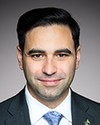I wouldn't call it worrisome, but I wouldn't call it normal either.
As I mentioned in my opening statement, our projections assume that no new measures or major policy changes are introduced. For our projections, we assume a status quo in policy actions. We look at the effects of economic changes over the long term that are a bit more predictable, such as demographic changes. Our projections take into account energy prices, the global economic and macroeconomic environment, current policy and announced policy actions whose implementation is almost certain. All of those considerations result in the figures you have before you.
That said, it's rare for a government not to make changes to government programs. Is it plausible to think that nothing will change and that government programs will carry on at the same rate? I don't think that's what's going to happen, because successive governments make changes to programs. However, government spending as a share of GDP can be expected to remain stable over time. That would not be unusual.
Regardless, a government may wish to play a stronger role and be more involved in the economy or, conversely, play a smaller role in the economy. That can happen in a variety of ways, either through direct spending or through higher or lower transfer payments to individuals.
Looking at program expenses in isolation likely paints a slightly distorted picture of real total government spending.




